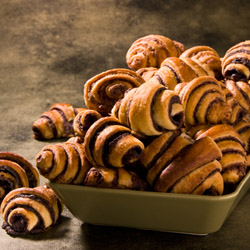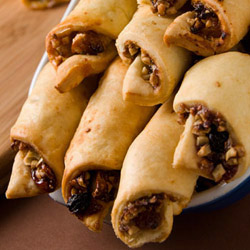
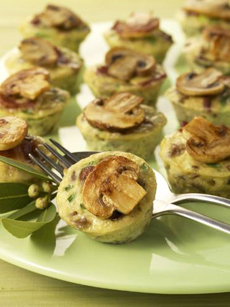
Mini-quiche hors d’oeuvres. Photo courtesy MushroomInfo.com. Here’s
the recipe.
June 2009
Last Updated July 2025
|
 |
Different Types Of Pastry
Quiche & Other Types Of Pastry & Pies
Pastry Glossary Page 9: Definitions With Q ~ S
The different types of pastry. This page contains terms such as quiche, shepherd’s pie, and short pastry. This is Page 9 of a ten-page glossary. Click the black link below to visit other pages. See our many other food glossaries, each featuring a different favorite food.
QUICHE
A rich and savory custard pie that originated in the northeastern France region of Alsace-Lorraine. The famous Quiche Lorraine is a bacon seasoned with cayenne and nutmeg; the original recipe did not include Gruyère or other cheese. The addition of Gruyère creates quiche au gruyère or a quiche Vosgienne. The addition of onion to quiche Lorraine makes quiche Alsacienne. Other quiches are made with ham, herbs, mushrooms, onions, and shellfish. Quiches can be served as a lunch or dinner entrée or as a first course; mini quiches are popular hors d’oeuvres. They can also be made without a crust, as shown in the photo at top left. Try this recipe for cheese quiche.
|
|
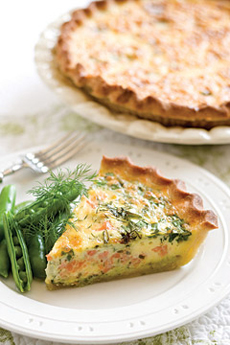
A smoked salmon and dill quiche. Photo courtesy MackenzieLtd.com. |
RELIGIEUSE
The French word for nun, this pastry is a type of cream puff. The current form was created in the early 18th century by the great Marie-Antoine [Antonin] Carême. He put together two choux pastry shells, one larger than the other, to emulate a nun in her habit; it’s a charming idea. A religieuse is typically filled with chocolate or mocha crème pâtissière and covered in a ganache of the same flavor as the filling, with piped whipped cream decoration. Modern pâtissiers use their skills to create bride and groom versions, sailors, Uncle Sam, and wherever their imaginations take them.
|
|
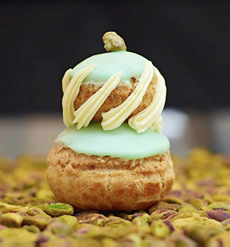
A fancy religieuse, replacing the nun’s traditional brown habit with pistachio green. Photo courtesy Dominique Ansel Bakery | New York City. |
ROLLING PIN
Rolling pins have evolved for specific purposes. The traditional pin with handles is ideal for rolling out pastry dough; the lightweight cylinder-style bakery pin in the center of the photo is used for small jobs like rolling out individual pastry squares or cookie dough; the French pin is the tool chefs prefer when rolling out thin piecrust.
|
|
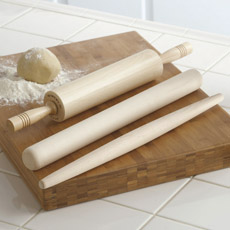
Rolling pins available at Chefs.com. |
RUGELACH
Rugelach is a traditional European Jewish pastry, a small, two-bite pastry that is either crescent-shaped or square-cut into a “snail” shape. Its name comes from the Yiddish “rugel,” or royal, and it goes by other names such as kipfel (in Hungary and the Czech Republic) and horns of plenty (in non-Jewish areas of the U.S., where people “rugelach” may not easily roll off the tongue). Rugelach are often classified as cookies, but they are really miniature pastries: soft, sweet dough with filling. They are enjoyed at any time of the day. The original filling was nuts, raisins, and cinnamon. Today, the repertoire has expanded to include fruit preserves such as apricot, cherry, and raspberry, raisins or currants, walnuts, and chocolate (filled with chopped chocolate or morsels), and much more.
|
|
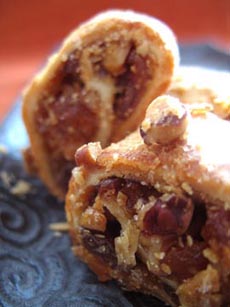
Cherry rugelach. Photo by Melody Lan | THE NIBBLE. |
People argue the virtues of a moister cream cheese dough over a sour cream dough; cream cheese is an American development, as the product did not exist in Europe. As for the many spellings of the word, rugelach was made in perhaps a dozen European countries by bakers who spoke a dozen different languages. It is variously spelled rugelah, rugalah, rugelach, rugalach, rugulah, rugelach, and ruggalach. Read reviews of our favorite rugelach in our Cookies Section.
Rugelach can be made in “homestyle” rolled or crescent styles. The rugelach available above is from Zabars.com.
RISSOLE
A rissole is a small croquette, enclosed in pastry or rolled in breadcrumbs. It is baked, deep fried, or cooked on a barbecue, and can be sweet, served as a dessert or snack, or savory (made of meat, fish, vegetables, or cheese), and served as an entrée, side dish, or snack.
|
SAWDUST PIE
If you like pecan pie, here’s a lighter, fluffier version with extra ingredients. The pie shell is filled with a very sweet filling of sugar plus coconut, graham cracker crumbs, pecans, and an egg white meringue. It was created in the 1970s by Patti Tullar at Patti’s 1880s Settlement, a restaurant in Grand Rivers, Kentucky. The dry ingredients resemble sawdust when mixed together before baking. Here’s a recipe.
SCONE
A scone is not a pastry but a quick bread, similar to a biscuit. See our Bread Glossary.
|
|
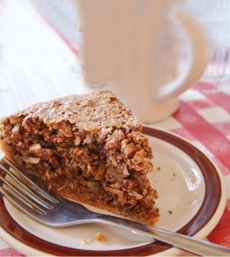
Sawdust Pie. Photo courtesy The Loveless Cafe. Here’s the recipe.
|
|
SCOTCH PIE
A Scotch pie is a small, round, double-crusted meat pie filled with spiced, minced mutton or other meat. Individual recipes can add baked beans, mashed potatoes, and a brown sauce or gravy. Scotch pie is believed to originate in Scotland, where it is often known simply as a pie, but it can be found in other parts of the U.K. It is popular takeout food and is often sold at football games and other outdoor events, so it’s occasionally called a football pie. It can be eaten as a hand pie. Think of it as the U.K. equivalent of a hot dog or hamburger.
|
|
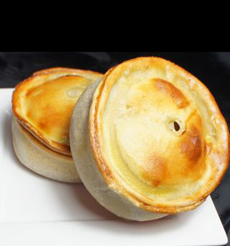
Scotch Pie, filled with seasoned, ground mutton. Photo courtesy Scottish Island Quality Meats.
|
SESAME PASTRY
Plain pastry with 1/4 cup of sesame seeds added to the paste. Ideal for cream pies.
SFINICI
An Italian specialty, fried dough balls filled with ricotta, miniature chocolate chips, and candied orange peel.
|
SFOGLIATELLA or SFOGLIATELLE
Sfogliatelle (plural, pronounced sfol-ya-TEL-lay) are one of the more famous Italian pastries, are clamshell-shaped and filled with citron- or orange-flavored ricotta, although other fillings, including almond paste, can be used. “Sfogliatelle” means “many leaves.” The pastry is formed when the center of the rolled dough is pressed outwards, which creates a cone-shaped pocket for the filling. The pastry was created in the convent of Santa Rosa in Conca dei Marini in the Campania region of Italy. By the beginning of the 17th century, the nuns were well-known for their sfogliatella Santa Rosa, flavored with limoncello, a lemon liqueur. Subsequently, other citrus liqueurs, including mandarinello (from mandarins) and arancello (orange), were used. A sfogliatella is not the same as a lobster tail, which is a similar, but more elongated, pastry shape.
|
|
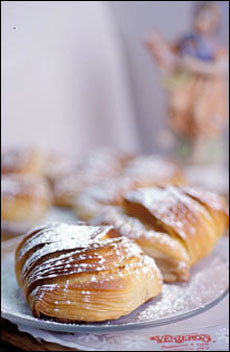
Sfogliatelle are available from Venieros.com.
|
|
SHEPHERD’S PIE
A dish consisting of minced meat, usually lamb but also beef, covered with a top crust of mashed potato, which is baked until it browns. There is no bottom crust. See also cottage pie. While the classic British recipe does not include vegetables, Americans have added corn, carrots,s and other veggies for variation (see photo at right).
SHOOFLY PIE or SHOO-FLY PIE
While treacle-based pies were popular in Medieval Europe, refined white sugar became more affordable in the Renaissance. In the American Colonies, the treacle pie resurfaced in Pennsylvania Dutch country, purportedly because a pie-baker had only flour, lard, and molasses on hand. Thus: a pie crust filled with molasses and topped with crumbs.
The name purportedly came from the pools of sticky molasses that formed on the surface of the pie, attracting flies. But according to Wikipedia, “The name shoo-fly was borrowed from a brand of molasses that was popular in parts of the U.S. during the late 19th century.”
Shoofly pie is related to pecan pie, in which pecans are mixed with a filling of eggs, butter, and molasses or brown sugar.
You may also find reference to a molasses crumb cake, sometimes called molasses crumb pie, that traditionally was not served as a dessert pie, but as a breakfast cake/pie to have with coffee.
|
|
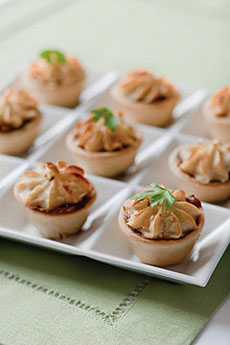
Hors d’oeuvre-size shepherd’s pies available from MackenzieLtd.com. While a regular-size pie does not have a bottom crust, these are baked in pastry cups as finger food.
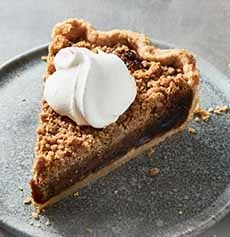
Shoo-fly Pie. Here’s a recipe (photo © Epicurious). |
SHORT PASTRY or SHORTCRUST PASTRY
A soft, tender pastry made from flour, fat, salt, and water, rolled into a dough. There are savory and sweet short pastry doughs; sweet doughs, for sweet pies, can add sugar and eggs.
SHORTBREAD CRUST
Like shortbread cookies, a shortbread crust (not to be confused with shortcrust, above, the popular pie crust) is made with three ingredients. The recipe for one tart or pie includes 2 sticks (1 cup) of softened, salted butter; 2 cups all-purpose flour, and ½ cup confectioner’s sugar. Just preheat the oven to 350°F; combine the ingredients into a dough and press it into the baking pan (pie, tart, 9x13 rectangle, etc.). Bake for approximately 12-15 minutes, until a light golden brown. Remove from the oven and cool completely before filling.
|
|
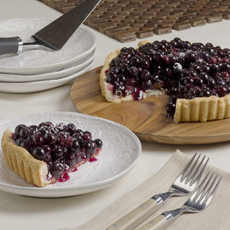
Unlike a pie crust, a shortbread crust keeps its shape without a pie plate or pan. Photo courtesy Chilean Blueberry Committee. |
SILK PIE or FRENCH SILK PIE or
CHOCOLATE SILK PIE
A one-crust chocolate pie that originated in the South. It has a graham cracker crust and a very rich, creamy, and “silky” chocolate filling (butter, sugar, chocolate, and eggs, plus vanilla). It is served topped with whipped cream and often, chocolate shavings. A French silk pie, made with chocolate (not cocoa), is different from a generic chocolate pie, which is often chocolate pudding in a pie crust.
SINGLE CRUST PIE
A pie with no top crust. There can be a topping, such as shredded coconut, streusel, or whipped cream.
|
|
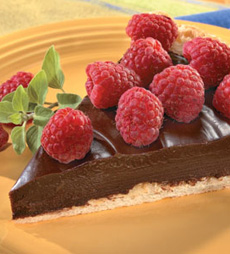
Silk pie with a puff pastry crust. Photo courtesy Pepperidge Farm, PuffPastry.com. |
SLUMP or GRUNT
A slump is an easy-to-make spoon pie of stewed or baked fruit topped with biscuit dough, which is rolled and placed on top of the fruit. It isn’t taut like a formal pie crust; it slumps. A slump can be baked or steamed; it can be made upside down.
The alternative name, grunt, may have come from the noise people made while eating it. Here’s a recipe from chef Claire Robinson for Pinnacle Vodka.
- 6 cups fresh fruit
- 3/4 cup granulated sugar, divided
- 1 cup self-rising flour
- Pinch salt
- 2/3 cup whole milk
- 3 tablespoons unsalted butter, melted
Preheat the oven to 375°F. Place fruit in a 9-inch pie plate and sprinkle 1/2 cup sugar. In a medium bowl, combine flour, salt, milk, butter, and remaining sugar. Whisk until well combined and pour on top of blueberries. Bake on the middle rack in the oven until golden brown, about 45 minutes.
See cobbler for related dishes.
Also see our article: Crisp, Crumble, Cobbler, Betty, Buckle & More: The Difference.
|
|
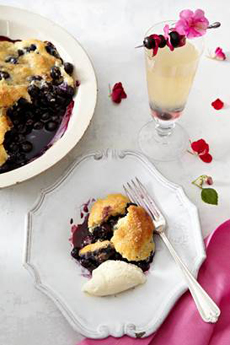
A blueberry slump. Photo courtesy Pinnacle Vodka.

A cherry grunt. Here’s the recipe from Taste Of Home.
|
SNICKERS PIE
A cream pie made of cream cheese, peanut butter, and chopped Snickers bars on a chocolate crumb crust. The top is typically decorated with chopped Snickers Bars and sometimes caramel and /or chocolate drizzles. There are many variations of the recipe; a Snickers ice cream pie can be made with vanilla or peanut butter ice cream, along with the chopped Snickers bars. Some cooks like to add chopped roasted peanuts into the recipe as well.
|
|
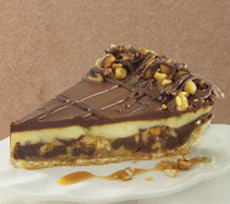
A pie for peanut lovers. |
SODA CRACKER PIE
Soda cracker pie is an old-fashioned dessert that originated in the Depression-era South. A crust of crushed soda crackers is topped with meringue, whipped cream, and walnuts. The crackers engender a sweet-and-salty profile. Soda cracker pie is one of numerous Depression pies created by housewives who sought desserts that used simple, inexpensive ingredients yet made something that tasted special. Here’s a recipe.
|
|

A pie for peanut lovers. |
SPOON PIE
A fruit pie with a filling so juicy it should be eaten with a spoon instead of a fork. See also Slump, above.
STICKY BUNS
Sticky buns are a breakfast pastry that have evolved since arriving in America with 18th-century German immigrants (including the Pennsylvania Dutch). Originally, leavened dough was rolled in a pan lined with “sticky” honey (later in America, maple syrup was an alternative) and nuts. Sometimes the dough contained brown sugar or cinnamon. After baking, the pan was inverted, and the honey and nuts became the topping. Today, similar products can be found commercially, as well as individual sticky buns made by fine bakers, which employ cream cheese pastry rolled with brown sugar, cinnamon, raisins, pecans or walnuts, and honey.
|
|
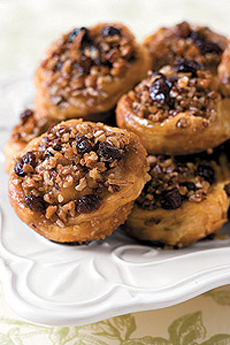
Sticky buns are available at MackenzieLtd.com. |
|
STIRRED PASTRY
An easy pastry, not as flaky as plain pastry or Catherine’s pastry. It uses salad oil (corn, cottonseed, peanut, or soy oil) as the fat, plus milk, pastry, or all-purpose flour, salt, and sugar.
STREUSEL
Streusel is a crumb topping of butter, flour, and sugar; it can contain chopped nuts or rolled oats. Pronounced SHTROY-zul, the word derives from the German “streuen,” meaning to sprinkle or scatter. Streusel is used as a topping for a variety of pies, fruit crisps, cakes, and pastries, most notably coffee cakes. A pie with a streusel topping is sometimes referred to as a “crumble pie.”
|
|
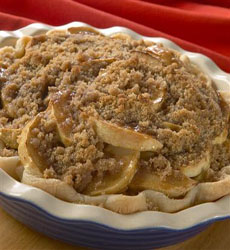
A deep-dish apple pie with two layers of streusel. Get the recipe. Photo courtesy McCormick. |
|
STRUDEL
Strudel is a sweet layered pastry with a filling that became very popular in the latter part of the Habsburg Empire (1278-1780), whose glittering capital was Vienna (the oldest strudel recipe is a handwritten recipe from 1696, now kept in the Vienna City Library). There are sweet and savory strudels. Popular sweet varieties include apple (often with raisins), cherry, cheese, and poppy seed; savory varieties include spinach and cabbage. Although associated with the Austro-Hungarian Empire, strudel has its origins in Byzantine Empire pastries such as baklava.
|
|
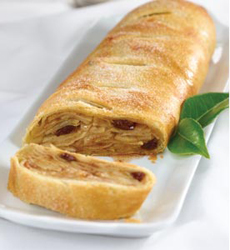 Apple strudel. Photo courtesy Pepperidge Farm. Apple strudel. Photo courtesy Pepperidge Farm. |
But while some people make strudel from phyllo or puff pastry, traditional strudel pastry dough is a very elastic and stretchable, not flaky dough. Supermarket products known as “toaster strudel” bear no similarity to a real strudel.
SUET PASTRY
Suet pastry is a short pastry to which suet (raw beef fat from around the kidneys and loins) is used instead of other fat. It is typically used for meat pies.
Continue To Page 10: Terms With T To Z
Go To The Article Index Above

|









